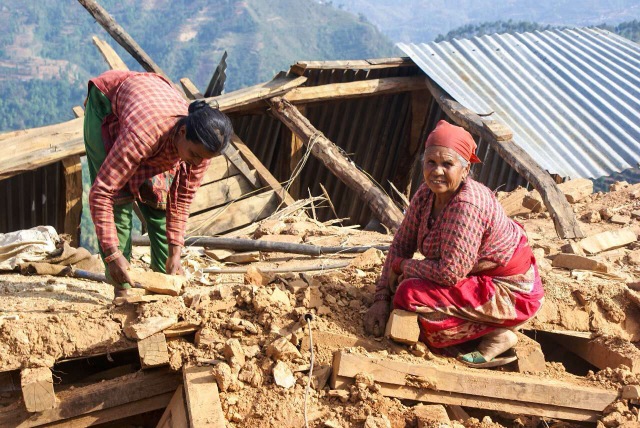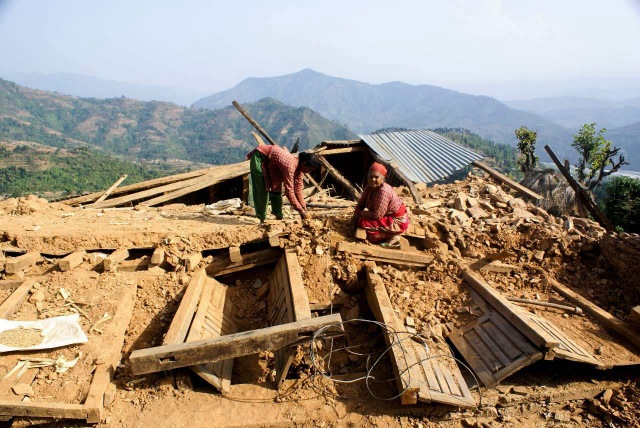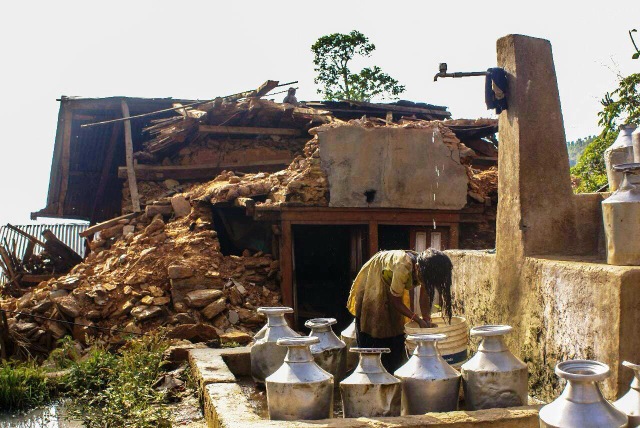
Sindhupalchowk district of Central Nepal (Photo: Peshal Pokhrel)
As a president of the newly-formed Nepalese Student Association at the University of Arizona (UA), Bhuwan Thapa – a PhD student in the School of Geography and Development – is working to build strong UA engagement in earthquake recovery by raising funds and relief items, and through the study of both natural hazards (particularly in Nepal), and of the human responses and adaptations to such events.
Thapa recently received a three-year Graduate Research Training Grant from the International Centre for Integrated Mountain Development (ICIMOD, based in Kathmandu, Nepal) under its Himalayan Adaptation, Water and Resilience (HI-AWARE) initiative, to work on the project: ‘Pathways to resilience: Adaptation in agriculture and water management to changing climate in the Gandaki River Basin.’
Robert G. Varady, deputy director of the UA Udall Center for Studies in Public Policy and director of the UA component of IWSN, interviewed Thapa about recent events in Nepal and how it has affected his work.
IWSN: You recently received a very prestigious doctoral research grant from ICIMOD in Nepal, but just four weeks after you learned of this award, a 7.8 earthquake struck your home city of Katmandu and the Gandaki River Basin that is the focal point of your proposed research. What has been your personal reaction to the devastation caused by the earthquake?
Thapa: The event has been a historical calamity for the country in all aspects, including human casualities and structural damage. More than 8,000 lives have been lost, and the number is expected to go up to 20,000 as government crews reach the unattended damaged areas in villages that can only be accessed by hours of walking. Thousands of people are mentally and physically traumatised by this event – with a significant loss to family life, social networks, and the human workforce of the country. Already, the massive migration of adult males to urban centres in Nepal and to other nations – such as India and Middle Eastern, African, and other Asian countries – has left rural villages with a diminished pool of labour, causing problems for rescue, relief, and recovery phases after the disaster. Nonetheless, the Nepalese people, local communities, and non-governmental organisations – with support from the Nepal Army and Police – have been working to fill this vacuum. This effort of helping each other is definitely a strength as we walk on the path of recovery. I am dismayed, however, that another major earthquake of 7.3 magnitude has happened nearly two weeks after the main quake of 1 May. People are already stressed, and these large-scale recurrent shocks only compound the high level of trauma.
IWSN: The earthquake has resulted in massive damage to the infrastructure in Nepal and particularly in your study area. What is your understanding about the damage and how do you think this will affect your research?

Sindhupalchowk district of Central Nepal (Photo: Peshal Pokhrel)
Thapa: The earthquake has caused significant impairment to all types of infrastructure and basic services. As of 11 May, USAID had reported that nearly 300,000 houses were destroyed and some 250,000 houses damaged. The subsequent earthquake, with its epicentre near the Mt. Everest region, demolished many houses that were on the verge of collapse as a result of the more than 130 aftershocks of magnitude 4.0 or greater since the first major event of 25 April. Large cracks, up to several metres in length, are seen in the valley roads, and frequent landslides are destroying houses and creating road blockages. In Sindhupalchowk (see photo), one of the worst hit areas, nearly all of the schools have been damaged.
According to the Nepal Electricity Authority, at least 14 existing hydropower dams have been damaged causing reduction in production capacity by up to 30%. Although the damage to agriculture and the region’s irrigation systems has not yet been assessed, we can expect major destruction of rural market places, irrigation canals, and food-collection centres – all of which threatens the food security of the region.
Many World Heritage Sites in Kathmandu Valley also have been destroyed by the earthquake. I viewed video footage of a large-scale landslide that occurred near Dhulikhel Hospital, which is about 20 miles east of Kathmandu City. Erosion, and these immense landslides, will worsen as Nepal receives its annual monsoon rains in about a month. I cannot imagine what the situation will be for millions of people living in poorly-built tents under a downpour that continues for days over a two-to-three month period.
Following this earthquake, I will modify some of my research questions. While I have wanted to understand the adaptation in water-resources management by small farmers and the implications of their actions on water security, I now realise the absolute necessity of incorporating the risk perspective. There are many timely questions that have risen on my research agenda, such as recognising the pathways of recovery in irrigation systems by assessing the social, cultural and behavioral factors that have made some villagers resilient to after-shocks events.
IWSN: The theme of your research is on adaptation and agricultural water security. In what ways do you think the earthquake and its aftermath are affecting the availability of sufficient quantities of good-quality water for residents?

village in Sindhupalchowk district of Central Nepal (Photo: Peshal Pokhrel)
Thapa: There is enormous destruction of infrastructure for basic services including roads, water supply, irrigation and hospitals. There is a shortage of drinking water in cities such as Kathmandu and affected rural areas, because the water delivery systems and the water taps in the houses have been completed destroyed (see photo). Many underground water supply pipes are broken, causing water leakages and contamination. The French Embassy has built a drinking-water treatment plant – with a maximum capacity of 200,000 litres per day – as an alternate system of water supply to the municipal water-service provider in the capital. The destruction is most severe in rural areas where very little infrastructure has withstood the shocks.
IWSN: Has this catastrophe changed your notions of how we should think about water security?
Thapa: UN-Water [the confederation of the water divisions of 31 UN agencies] defines water security as safeguarding quality and quantity of water for various human and environmental needs and ensuring protection from pollution and natural disasters. While much of the discussion on water security to date has focused on water quality and quantity, as this earthquake has clearly demonstrated, the water insecurity resulting from natural disasters can be very substantial and of long duration. With climatic change and variability, we are likely to see more natural disasters and hence more disaster-induced water insecurity.
